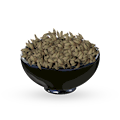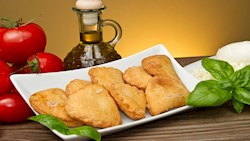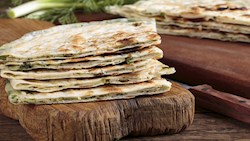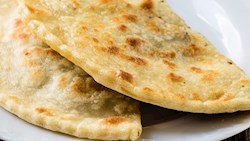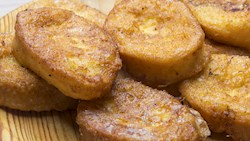MAIN INGREDIENTS
Known as karantika in Algiers and calienté in Morocco, this beloved traditional dish traces its origins back to Spanish influence during the colonial period, as its name is derived from the Spanish word calentita, which means "warm." Over time, what began as a humble, filling meal for the working class evolved into one of Algeria’s and Morocco's most cherished street foods, often enjoyed by people of all ages and backgrounds.
The essence of the dish lies in its simplicity and rich, comforting flavor. It is made from a smooth batter of chickpea flour, water, oil, salt, pepper, and eggs, which is then baked until it develops a golden, slightly crisp crust on top while remaining creamy and custard-like inside.
The pan-fried variety of the Chinese jiaozi dumpling, known as guotie, is a Northern Chinese dumpling typically filled with minced pork, Chinese cabbage, scallions, ginger, rice wine, and sesame seed oil. Crunchy and soft textures are achieved by a special method of preparing; while the bottom of the dumpling is frying, a small amount of liquid is added to the pan which is then covered, thus allowing the rest of the dumpling and the filling to steam.
When it comes to the shape, guotie should always be long and straight as it can stand more easily and it does not fall over during cooking. Goutie can be literally translated as pot sticks, so these dumplings are often nicknamed potstickers, especially in North America.
MOST ICONIC Guotie
View moreMAIN INGREDIENTS
Hamamatsu is a popular variety of Japanese gyoza filled with cabbage, onions, pork, and selected seasonings. It is characterized by a unique frying style in which cooks arrange gyoza in a circular pattern (hanetsuke, a technique in which a crispy bottom connects all the gyozas) so that they can fry as many snacks as possible at the same time.
It is very popular to pair Hamamatsu gyoza with a topping of bean sprouts.
Esquites is the name for popular Mexican street food that is usually consumed as a snack on the go. It is made with mature corn kernels, epazote, and salt. Corn is either grilled and shaved, or cooked with epazote, and it is then typically served in small cups, topped with chili peppers, lime juice, or cotija cheese.
Sour cream, mayonnaise, and pequin chili powder are sometimes served on the side so everyone can add the ingredients according to personal preferences. The name esquites is derived from the Nahuatl word izquitl, meaning toasted corn.
MOST ICONIC Esquites
View moreOne of the most famous snacks in Indonesia is batagor, a fried fish dumpling served in a traditional spicy sauce. It has roots in the Chinese culinary tradition, which has left a trace on many Indonesian dishes. Although this famous snack is reminiscent of the more famous Chinese dumpling, its distinguishable characteristic is that it is fried, not steamed.
The most common fish used to make the dish is wahoo, but tuna, mackerel, and even prawns can also be used. Potatoes, tofu, or cabbage are also occasionally added to the dish. Batagor is the perfect snack because of the way it is served. When fried, the dumplings are cut into small bite-sized pieces and covered in peanut, soy, and chili sauce with a splash of lime juice.
MOST ICONIC Batagor
View moreAntojitos (lit. little cravings) refers to a variety of Mexican foods that are prepared in market stalls and on the streets. Due to the fact that formal, substantial meals are consumed in the mid-afternoon, most antojitos are eaten either in the morning or the evening.
Typical antojitos include fajitas, tortas, tamales, tacos, tostadas, tlayudas, elote, chalupas, gorditas, empalmes, quesadillas, cemitas, empanadas, pambazo, chilaquiles, and nachos. However, vegetables, fruits, and soups such as pozole and menuda are also classified as antojitos.
The famous Japanese gyoza are crescent-shaped dumplings that have originated from the traditional Chinese jiaozi dumplings. The recipe was slightly altered to accommodate the Japanese taste, and gyoza soon became one of the favorite Japanese meals.
They consist of a thin wrapper made with wheat flour, eggs, and water, which is then stuffed with a mixture of meat and vegetables. The ingredients used in the stuffing are regionally influenced, but most commonly include minced pork or chicken, cabbage, chives, a substantial amount of garlic, ginger, and green onions.
VARIATIONS OF Gyoza
MOST ICONIC Gyoza
View moreMAIN INGREDIENTS
This simple cheese bread known as khachapuri is the most famous dish in Georgia. It is traditionally topped with melted cheese, eggs and butter. There are different types of khachapuri, and even though some new cheese varieties such as mozzarella and feta have been incorporated in the dish, the most common additions still include traditional Georgian Sulguni or Imeretian cheese.
It is shaped into different forms, and depending on the baking procedure and its form, it can be consumed individually or shared. Two of the most common varieties include the Imeretian khachapuri, shaped into a circular form, and Adjaran khachapuri, the open-faced version topped with butter and a raw egg on top.
VARIATIONS OF Khachapuri
MOST ICONIC Khachapuri
View moreMAIN INGREDIENTS
Sfiha, or lahm bil ajĩn (lit. meat on dough) is an Arabic specialty that dates back to the 15th century, when it first appeared in today's Eastern Lebanon. The traditional open-faced meat pie is popular throughout the Arab region, its main ingredients usually including minced lamb (or lamb), chopped onions and tomatoes, spices, olive oil, and yogurt.
Originally, the dish was prepared by stuffing ground lamb and spices in brined grape leaves, but it evolved over time. Sfiha is also popular in Brazil and Argentina, where it was brought over by Levantine immigrants. It is usually consumed hot as a snack, accompanied by tahini sauce or a bowl of yogurt, while pomegranate seeds, coriander, or chopped cucumbers are often used as garnishes.
VARIATIONS OF Sfiha
MOST ICONIC Sfiha
View moreMAIN INGREDIENTS
Literally translated to cheese bread, pão de queijo has its origins in the culinary inventions of African slaves, when they started to use the residue of the cassava plant. A fine white powder, or starch, was rolled into balls and baked.
At the time, no cheese was added, so it was just baked starch, but at the end of the 19th century, when slavery ended, other foods started to become available to the Afro-Brazilians for the first time. In the state of Minas Gerais, the dairy center of Brazil, cheese and milk started to be added to the starchy balls, and pão de queijo was created.
MOST ICONIC Pão de queijo
View moreTasteAtlas food rankings are based on the ratings of the TasteAtlas audience, with a series of mechanisms that recognize real users and that ignore bot, nationalist or local patriotic ratings, and give additional value to the ratings of users that the system recognizes as knowledgeable. For the “Top 100 Snacks in the World” list until April 15, 2025, 65,169 ratings were recorded, of which 43,870 were recognized by the system as legitimate. TasteAtlas Rankings should not be seen as the final global conclusion about food. Their purpose is to promote excellent local foods, instill pride in traditional dishes, and arouse curiosity about dishes you haven’t tried.






